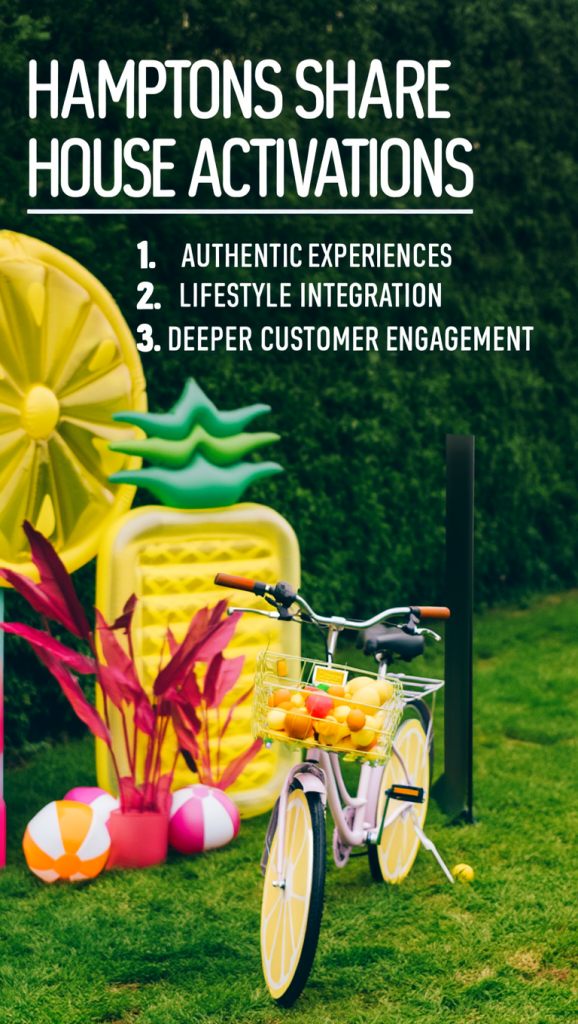The iteration problem of traditional showrooms
In the old model luxury brands opened refined showrooms in urban cores. They invited VIPs, staged displays, held trunk shows. It worked. But the system is fatigued. As one analyst noted: “People go to the Hamptons to spend money, and shopping is one of the main activities.” A showroom is static. It says: come to us. A sharehouse says: we’ll come to your world.
The Hamptons as context rather than backdrop
Consider the region itself. The Hamptons has evolved into a full-blown experiential marketplace. According to EventMarketer: “Several brands swapped the city for the coast this summer … pop-ups and exclusive events… hosted all summer long.” That tells us the place is no longer just picturesque—it’s strategic.
Why a sharehouse beats a showroom in the Hamptons game
Here’s where the magic happens: A sharehouse gives a brand access to a live environment of high-net-worth individuals, a summer mindset, and leisure time. It replaces the showroom’s curated coldness with warmth, dwell time and content creation potential. It says: this is how you live with our product. That makes the case clear that luxury brands should rent Hamptons sharehouses if they want to shift from selling objects to selling lifestyle.
Three activation pivots inside the sharehouse model
- Immersion over display: A brand dinner held in a sharehouse living room invites guests to experience product in real context.
- Content capture as collateral: The architecture, the pool, the cocktail hour—these become shareable assets, amplifying value.
- Audience dwell time: Guests stay overnight, linger, engage. That time transforms into meaningful brand interaction.
Market signals: why now is the moment
In recent years the Hamptons has tightened its luxury real estate game. One piece notes how “share houses … that house culture for twenty-somethings” are being priced out. In other words: scarcity is real. A brand renting a large sharehouse isn’t just buying space—it’s buying access to scarcity, status and signal.
Real estate + brand activation = compound leverage
As I outlined in my own piece for Social Life Magazine, Southampton has become “the open-air showroom for prestige.” When you pair that environment with product, content and affluent guests it becomes far more than an ad. It becomes a narrative that people want to join. That’s the leap from showrooms to sharehouses.
From cost center to strategic asset
Brands often view venue rental as cost. But in a sharehouse model the rental, the content, the audience and the narrative integrate to drive ROI. One study of Hamptons activations observed: “Brands will continue innovating … with immersive experiences and deeper community engagement.” So the cost becomes strategic investment—not display space.
How to structure a sharehouse activation (step-by-step)
Here’s a simple blueprint:
- Choose a sharehouse in a high-end hamlet (Southampton, East Hampton, Bridgehampton) for its social signal.
- Define your luxury brand’s story in context—what lifestyle are you selling beyond the product?
- Frame guest access: invite HNW insiders, influencers, media contacts—create VIP alignment.
- Design the experience: from welcome drinks to poolside styling sessions to overnight stays.
- Capture content: hire a creative team to photograph, film and build social assets tied to the brand.
- Follow up: use CRM, retargeting, media coverage—your sharehouse becomes a funnel.
Why showrooms alone don’t create the needed narrative
A showroom says: this is our product. A sharehouse says: this is your life with our product. The difference is subtle but real. In the Hamptons, where status is lived, not just displayed, that difference becomes premium. If your brand still relies solely on traditional showroom presence, it’s missing the opportunity. Because when luxury brands should rent Hamptons sharehouses, they shift from display to immersion.
Metrics that matter for sharehouse activations
When you pivot to sharehouses over showrooms, the success metrics change. Instead of foot-traffic and window conversion you look at:
- Number of VIP overnight guests
- Dwell time on site
- Content assets created (videos, photography, influencer posts)
- Media mentions + earned impressions
- Direct leads or CRM opt-ins post event
- Attributable sales lift or referral traffic to brand site
Risks and how to mitigate them
Risk: a sharehouse feels sloppy or unfocused. Mitigation: treat it like a mini-luxury hotel. Risk: guest list misalignment (too many generalists). Mitigation: curate HNW + brand-aligned individuals only. Risk: content feels generic. Mitigation: integrate your brand story with the setting—make the space uniquely yours.
The play for luxury brand strategists
If you’re a luxury brand marketing lead—or a media strategist pitching brand participation—here’s your edge: propose the sharehouse model as a service offering. You can combine real estate access (the house), media amplification (my platform at Social Life Magazine coverage) and brand activation expertise into a one-stop solution. Because when luxury brands should rent Hamptons sharehouses, they also need a trusted partner who knows the ecosystem.
Summary: shift from showrooms to sharehouses
In a crowded luxury marketing environment, the true differentiator is story. A showroom is passive. A sharehouse is narrative in motion. By leveraging the Hamptons’ cachet, owning the environment, and treating the house as a brand platform, you unlock far more than exposure. You unlock status, content, audience and conversion. So if you’re wondering how to elevate beyond the showroom—consider this: luxury brands should rent Hamptons sharehouses, not just showrooms.
